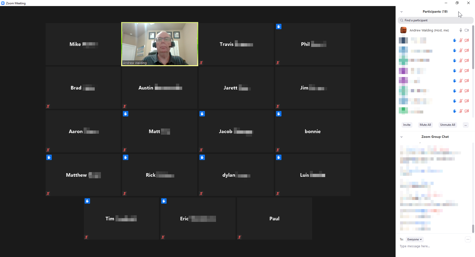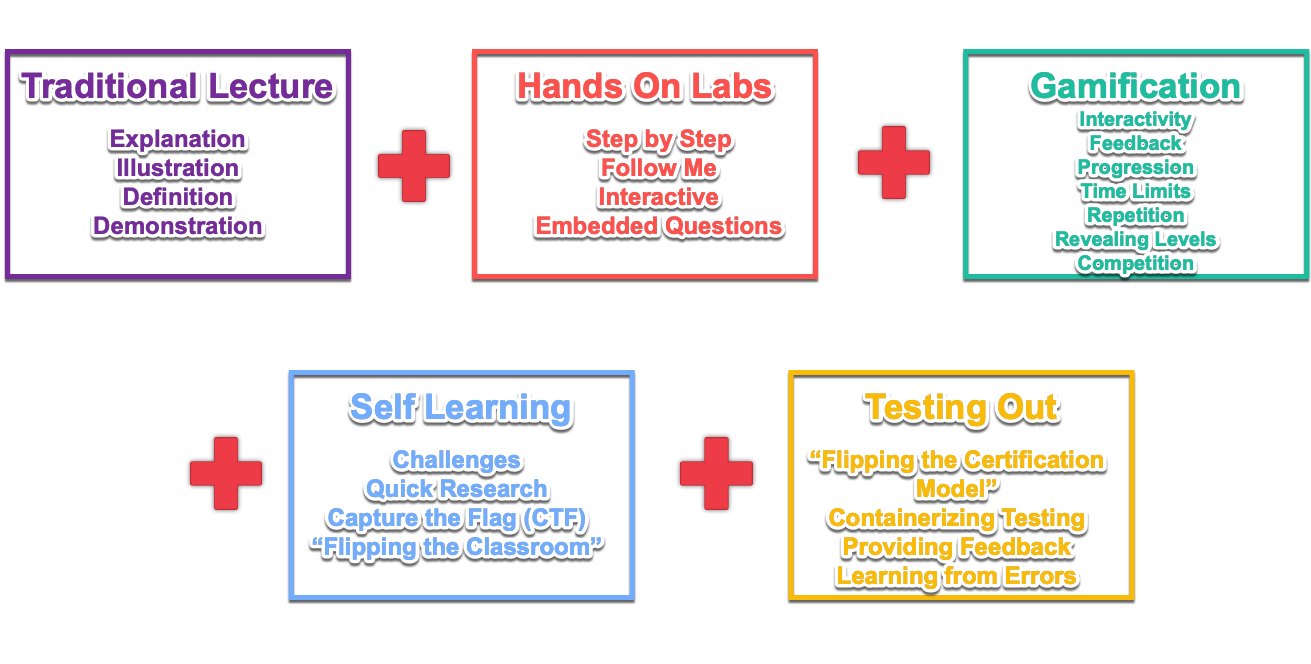 The Coronavirus (SARS-CoV-2) pandemic and the COVID-19 disease has changed our lives: the way we socialize, travel, exercise, work, play, and learn. Social distancing by working from home and learning from home has become a requirement, not just a lucky or cool thing. This has resulted in an almost overnight dependency and test of how absolutely fantastic the Internet and the applications that run on the Internet truly are. While ZOOM meetings, Skype calls, Facetimes are keeping us distance connected, we are missing the in-person social interaction at work, meetings, and training. We are connected, but alone a lot of the time.
The Coronavirus (SARS-CoV-2) pandemic and the COVID-19 disease has changed our lives: the way we socialize, travel, exercise, work, play, and learn. Social distancing by working from home and learning from home has become a requirement, not just a lucky or cool thing. This has resulted in an almost overnight dependency and test of how absolutely fantastic the Internet and the applications that run on the Internet truly are. While ZOOM meetings, Skype calls, Facetimes are keeping us distance connected, we are missing the in-person social interaction at work, meetings, and training. We are connected, but alone a lot of the time.
For some, this new modus operandi is not an issue, but for others it is hard to stay focused and remain refreshed. We have heard complaints of screen fatigue, for example. This was one of the major issues that people cited as troublesome when online training became a thing using tools like Citrix, Webex, and other similar tools long before quarantine or lockdown in Feb/Mar of this year.
We began teaching on Webex before Cisco ever acquired it. Webex was founded in 1995, and Cisco acquired it in 2007. We were teaching online back in 2001, before anyone had any advice to offer on what was good, right, or the opposite. So for us, 2020 marks the 19th year of creating and teaching courses via Web Based delivery. Along the way we learned a ton. Are we perfect? No way, but we hear from students that we are better than most, and we are proud, yet humbled, and a little paranoid, as we continue to strive to be even better, every course we deliver.
In a recent discussion here at CellStream HQ about what we have learned, and how we design our online training, it was evident that we have never shared what we have learned, and with teachers, both educational and professional, climbing the steep curve of web based delivery learning, we thought we should make this blog post. We hope what we have to say is helpful to everyone, and we welcome comments and additional thoughts.
There are some major milestones that we have passed, and while each of these was important, the details would make this post long, boring, and miss the main point which is to share what works. Here are a couple of those milestones:
 When CellStream, Inc. was founded in 1998, and training was 50% of our business, we adopted Bloom’s Taxonomy of learning (you can read more here). This remains with us ever since, but as you will see we added to it. E-Learning was all the rage and in 1999 we used a service called Intranets.com as well as out own web site.
When CellStream, Inc. was founded in 1998, and training was 50% of our business, we adopted Bloom’s Taxonomy of learning (you can read more here). This remains with us ever since, but as you will see we added to it. E-Learning was all the rage and in 1999 we used a service called Intranets.com as well as out own web site.- While Blooms Taxonomy was where we started and continue to this day, back in 2000, we also have adopted what Confucius apparently said in 450 B.C.: “Tell me and I forget…Show me and I remember…Let me Do [or Involve me], and I understand.”
- In 2001, an open source Learning Management System platform called Moodle appeared. The early versions were sketchy, but we liked what we saw. We were also an Intranets.com customer and we used that platform to help our students learn and interact with online learning in a more engaging and fulfilling way.
- In 2005 Webex bought Intranets.com and now we were $1000 a month subscribers to both services (yes it cost that much back then). We also experimented with Microsoft’s Livemeeting platform. When this acquisition happened, some of the things we were promised or had asked for to help us in our consulting and online training fell to the wayside. It was at this point that we jumped in with Moodle as more than just an experiment. We knew that we wanted a more engaging online experience when learning via web based delivery. We broke up lecture with online, hands on labs – sometimes dedicating 50% of the class time to this
- We provided references beyond what was covered in the courses so that students could continue researching and learning
- We deployed “follow me” learning practices to course design which reduced slides and increased engagement
- In 2010, we deployed a Moodle-based learning site, and we had jumped on a bandwagon that we did not know even existed, even though it had been introduced years earlier: Gamification. I will talk more about this below, but thanks to the great folks at Moodle what we were doing was in line with this white hot topic at the time.
- In 2013 we had an epiphany that certification program design were outdate and more a revenue generation mechanism that learner focused. We introduced something we called “flipping the certification model”, where you take a series of tests instead of one big test up front, enabling the student to test out of certain skill/knowledge sets, and then they could simply focus on what they needed to know, and then retest on those portions to become certified. You can read more about this and even certify here. Our students and client love this approach. It saves time, money, and works wonderfully.
Which brings us to the main point of this blog post. If you are going to teach a course online, as a web based delivery modality, what are some of the key things you must do to make the experience the best possible learning experience? As a teacher, how can you engage, motivate, and get the best retention out of your learners?
A couple of caveats:
- It is not our intention to imply nor state that the answers we provide work for any age group or any learner.
- We have spent our 20 plus years training adults, 18 and older, on complex networking and computing technology topics.
- Corporate culture plays a big part in how our methods, or any method for that matter, succeed and impact learning. We adjust our tried and true techniques to those varying cultures.
- Student motivations vary greatly – what sounds like fun and engaging to one student may seem silly or daft to another. The key in design is to find balance and to know you can’t get perfect reviews/scores from everyone, every time. With experience comes the ability to identify these motivations in real time, and adjust as needed.
- We presume continual improvement. In this electronic environment, slides can be updated, quizzes adjusted, hands on lab exercises changed, all in very reasonable times with a minimum of effort. We are never satisfied with our course design and content. The days of writing a book and then sticking to what is between the book covers are long gone. We always incorporate valuable student feedback and we iterate.
So please consider these as you digest what we do, and how we do it.
We use the following high level course design principles, and you should as well:

Traditional Lecture
Some will say this has to go away. We don’t agree with that as a binary thing. We say it has to be balanced. Most instructors will use Powerpoint (or similar) slides for this, which they will share within the web delivery platform or share their desktop. The key to web based delivery lecture is to keep the learner engaged. It takes time to prepare slides with just the right amount of animation, not every bullet on every slide, but rather when learning points dictate separation or revelation.
Another key to making the lecture portion of an online course work is to not use the mouse cursor spinning or running around, or sliding back and forth (we see presenter do the same with laser pointers and it is terrible). We say point and hold. Further, we use pens with displays that allow writing on the slides (the folks at Wacom have great products for this – and they are not a sponsor, but if someone at Wacom wants to call us….), illustrating key points, and annotating slide content. We have done this for so many years that we actually design this into the slide materials. This practice brings the content alive, makes it organic for the learner, rather than static, just like the chalk board or the whiteboard does in a normal classroom. Some of the meeting/training tools like Webex or HP My Room or Citrix have this built in, but teachers use their mouse which has inaccurate movements and is almost impossible to write clearly with.
Traditional lectures must be enhanced with actual demonstrations – these are not follow me – that comes separately – but rather showing examples. Anything goes here: photos, live demos, screen recorded demos, etc.. “Show me and I remember”.
The teacher has to go further than the slides. There has to be references, backing facts, important additional content, further learning. These can be tangential, and this has to be readily available and accessible during the course and/or after.
Our experience is that attention time during these lecture portions of the web based delivery varies, but if you blend all the above, we find about sixty to seventy five minutes is the maximum straight time before at least a 10 minute break is necessary. Keep timers, use them, so everyone gets in sync. Start, Stop, and break on time. It is a respect thing and an important thing.
Hands On Labs
Before we had our online school site, we knew from Bloom’s Taxonomy that having hands on learning experiences, whether they were step by step, or follow me experiences, that students became more deeply engaged, retention went up, and skills they could use the day after class were developed. These hands on exercises can vary in type and depth depending on what you are training.
For our focus, we started by building racks of what we called lab routers and switches, but hanged as early adopters of emulation software (specifically GNS3) when it was first available and even today, to build and create network environments that students could leverage. Teachers must spend considerable time researching this area and developing these hands on experiences.
That said, we understood that not everything could be emulated, and so we used learning checks and essentially quiz exercises so the students could practice what they had learned. As we moved to the LMS, we saw so many options here, and we invested in leveraging every one of them.
I want to digress slightly here. Some do not like tests. They can be stressful, and too competitive. To some extent we agree, but we have always flipped the thinking on traditional testing, instead to use these methods as vehicles of learning. Let me explain: for most of your traditional victorian learning experience as a child you have to pass a test to pass a class. High grades get rewards, low grades do not. Often, and this certainly happened with my own children, the students don’t even get to see what they got wrong! At CellStream HQ, we thought from the beginning that this is backwards for most (not all) learning. The quiz or test function should also be a learning experience. You should be able to learn from your mistakes, with the ability to re-learn, re-test, to earn that knowledge or skill. We have found that if this occurs, retention is higher, and motivation is higher. For certification, the test function can and should be used as a measuring stick, but still correct answers should be provided. To reduce the cheating possibilities this means careful development of a bank of questions that introduce variability while testing the same knowledge and skills and using randomization in question order and answer order: something our LMS, any LMS, does or should do by rote.
We like to embed quiz questions within our hands-on labs, creating a challenge within the exercise, even if we use follow me, so that we pause the step by step process, induce systematic analysis, and learn from misunderstanding.
In the design process, we shoot for 50% Hands-On/Lab time, but often miss that mark due to the complexity of the subjects we cover. Nonetheless it is our watermark and as we iterate our classes, make them better, we keep reaching to meet or exceed this watermark.
Gamification
Let’s start right off by clarifying that from what we have seen and heard most experts advise it is not clear as to whether making learning a ‘game’ leads to improved comprehension or retention. That is not the point of gamification, at least in our opinion and experience. So let’s define gamification and how we subtly weave this into our class design.
There are many definitions of Gamification out there. We have found none that we dislike, and a simple definition is that “gamification is the act of applying game principles to improve non-game things”. So what are some of these game principles?
- Interactivity
- Feedback
- Progress Indicators
- Time Limits
- Repetition
- Unveiling of Levels
- Scoreboards
- Badges and Awards
- Social Interaction
Here is how we have implemented these concepts to our online course designs:
- Using an Avatar: users/learners cap upload their picture or an avatar – a concept that is present in most computer games. This gives them an image among their cohorts
- Teaming: this is accomplished by grouping learners and using co-horts
- Progression: we do this by showing completion tracking and building in completion criteria in the course design
- We provide conditional access to subsequent course content, meeting the game concept of revealing levels
- We build in Quiz/Task Scoring – which can inspire competitive motivation
- We employ Badges – a digital reward for either activity or course completion. These badges can then be shared beyond the scope of our Online School.
- We use the concept of leveling up, think of them like experience points. This expands the notion of completion tracking to a new level.
- You earn a certificate for completing our courses – yet another digital reward.
- We use a system (called Stash) that supports learners collecting items as they progress through the course, that when combined together earn a Flag or other specified item.
Truth be told, we do not deploy all of these in every course. Think of them as a set of design enhancements that support the gamification of our courses, which leads to motivation, interaction, and comprehension/retention underlining “Let me Do [or Involve me], and I understand.”
Self-Learning – Flipping the Classroom
We separate this component of the course design from the Hands On Labs component because it requires a higher level of design. Hands On labs and/or Follow Me labs are generally step by step procedures, where either the instructor or a procedure document are critical in leading the student through the process. By contrast, the Self Learning experience sets the student off with certain objectives, defines perhaps some environmental constraints, and then lets the student research and learn to achieve those objectives.
In the hacking world, these components are often called “Capture the Flag” competitions. In the traditional learning space folks refer to these practices as Flipping the Classroom. Usually this flipping involves activities outside the class time, which is certainly possible, but we generally don’t leverage that too much. Instead we take an approach to time during the class.
Below is an example of this type of exercise:

It is always important to have a time limit, and to set learner expectations that they may not complete the exercise, and that it is alright. Also a promise that in the end, the best approach will be shown. Sometimes, time allows for a student or two to demonstrate (via sharing screens) how they believe they solved the challenge.
The bottom line, is that students are teaching themselves, through trial and error, through researching on Google or provided resources, and through building on their own knowledge how to accomplish something new.
As previously stated, this requires deep instructor knowledge and experience. Even with that, be prepared to iterate and continually improve this type of component in your online classes.
Testing Out – Flipping the Certification Model
We won’t spend a lot of time in this blog post on this subject. You can read more on this subject right here.
I hope you find this article and its content helpful. Comments are welcomed below. If you would like to see more articles like this, please support us by clicking the patron link where you will receive free bonus access to courses and more, or simply buying us a cup of coffee!, and all comments are welcome!

